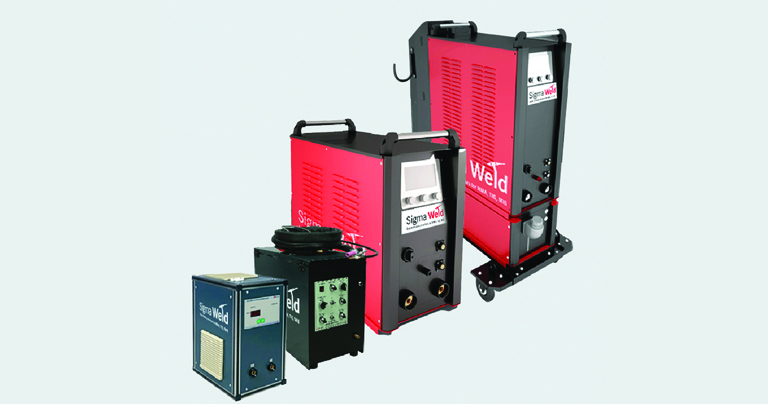S.W.A.T Helping Speed up Indian Manufacturing & Export Potential in Stainless Steel and Exotic Materials
By Edit Team | October 7, 2023 2:40 pm SHARE

India’s ascent in the global manufacturing arena is propelled by innovations like Sigma Weld Accelerated TIG (SWAT). Dive into the world of SWAT welding and its impact on India’s industries.
The world is well aware that this could be India’s decade, if not century, for all the right reasons. India is in a unique situation, boasting industrial excellence and a robust workforce, which puts it well to respond to the expanding international demand in the manufacturing industry, which is expected to grow at least 7% to 12% year on year.
TIG welding, sometimes referred to as gas tungsten arc welding (GTAW), is regarded as one of the cleanest and most popular welding procedures. It is amenable to automation and works in a variety of welding situations. It is often considered to be expensive and slow, though. Is it possible to improve TIG welding’s efficiency and cost-effectiveness in light of the rising demand for welding exotic materials? If yes, how?
Most people are aware that manual TIG welding uses filler wires that are cut to 1-meter lengths. However, approximately 4 inches of this length is rendered unusable since the welder cannot safely reach it with the welding arc. This wastage accounts for approximately 10% of the total filler wire consumption. As a result, the process’ overall cost is greatly increased because you need to buy 1.1 kilograms of filler wire for every kilogram of deposition that is needed.
For an 8mm thick single V joint, manual TIG welding moves along at a rate of around 55 to 60 mm per minute. Such a weld would normally take four passes to finish. Hypothetically, this would result in a total weld length of 6 meters for a seam of 1.5 meters, or 1.5 meters multiplied by 4 passes. At a welding speed of 60mm per minute, it would necessitate at least 100 minutes of welding time, accounting for interruptions due to filler wire starts and stops, as well as inter-pass temperature adjustments, which can easily extend the total time to 180 to 240 minutes. These are not just questions but pressing concerns, right?
The answer to all these questions lies in the affirmative, particularly for manufacturers operating in specific segments such as;
– Defence & Aerospace
– Tube Mills
– Cryogenic Vessel
– Tank & Vessel
– Food, Pharma & Dairy Equipment
– Nuclear
A novel, faster and highly efficient procedure known as Sigma Weld Accelerated TIG or SWAT has revolutionised TIG welding. SWAT is an automated keyhole welding procedure that, for materials up to 10 mm in thickness, can increase welding speed by up to 100% compared to conventional GTAW.
How does SWAT work?
First and foremost, this technology and process is easy to learn and easier to adapt. In simple terms, a highly concentrated arc pierces through the material’s thickness, creating a keyhole and swiftly carrying it through and through at nearly three times the speed of GTAW.
One of SWAT’s standout features is its constricted arc, which delivers almost three times the arc force when compared to GTAW. This extra force is essential for melting the pool under the same energy parameters, resulting in deeper penetration while mitigating the adverse effects of excessive heat. Furthermore, SWAT boasts low energy consumption, minimal distortion, and the versatility to be used with or without filler wires.
Now let’s compare SWAT with the existing GTAW process. You will observe that there is a huge difference between the two, and that SWAT substantially reduces material consumption, gas usage, and preparation time.
Data calculated for 1m of joint
Would it surprise you to learn that, in the case of Tube Mill Applications, welding using SWAT is achieved at nearly double the speed compared to a plasma & TIG combination with a single torch and a single process, all without the need for additional filler? Each weld subjected to SWAT in Tube Mill Applications underwent rigorous standard tests and configurations such as RTR, flaring, bend tests, and radiography. Remarkably, the SWAT process ran continuously for multiple shifts, without any interruptions, and consistently delivered outstanding results.
SWAT has delivered exceptional results to industries via productivity gains and cost savings; not only in terms of lesser weld time and lower energy input, but also by its ability to weld up to 14mm in a single pass. This, in turn, translates to significant savings in labor costs, consumables, and post-weld cleaning time. SWAT is an application whose time has come.
Spokesperson – Nimesh Chinoy,Marketing Director, Electronic Devices Worldwide Pvt. Ltd.Electronic Devices Pvt. Ltd.
Cookie Consent
We use cookies to personalize your experience. By continuing to visit this website you agree to our Terms & Conditions, Privacy Policy and Cookie Policy.





































-20240213125207.png)

























